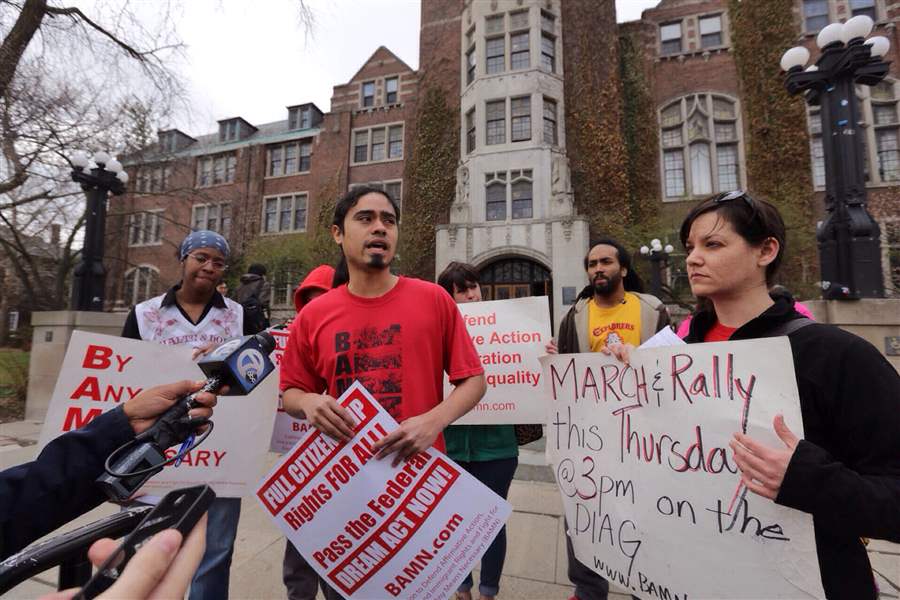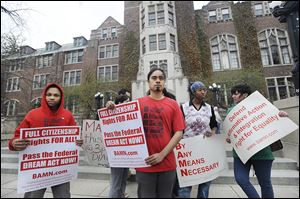
SUPREME COURT RULING
Mich. can’t factor race in decisions
Justices back 2006 votein university admissions
4/23/2014

WASHINGTON — The U.S. Supreme Court has determined that Michigan voters had a right to approve a state constitutional amendment banning the use of race-conscious preferences as part of the admissions process for state universities.
While the justices agreed 6-2 with the decision issued on Tuesday, they did not necessarily agree on the reasons.
The opinion delivered with the judgment of the court was written by Justice Anthony Kennedy, who was joined by two other justices, including Chief Justice John Roberts, who also filed a concurring opinion, and Justice Samuel Alito.
Justice Antonin Scalia also filed a concurring opinion, joined by Justice Clarence Thomas.
Another concurring opinion was filed by Justice Stephen Breyer.
A dissenting opinion was filed by Justice Sonia Sotomayor and was joined by Justice Ruth Bader Ginsberg.
Justice Elena Kagan recused herself.

Jose Alvarenga, center, national organizer for By Any Means Necessary, and others protest the Supreme Court ruling on the campus of the University of Michigan Tuesday in Ann Arbor. The justices upheld Michigan voters’ right to amend their state constitution on public university admissions decisions.
Ken Gormley, dean and professor at the Duquesne University School of Law in Pennsylvania, said, “I don’t think this changes the landscape very much in the area of racial preferences under the constitution.”
He said, “A plurality decision has less weight by definition because there is really not a majority of the court agreeing.”
Attorney Olabisi Okubadejo, who is with the Baltimore office of a law firm that represents colleges and universities on civil-rights compliance issues, said, “It’s very clear where the court has come out. The court has said the ban enacted by the voters is OK.
“What is less clear is exactly why it’s OK under the constitution, and it’s also not clear what this will mean for future cases.”
Mr. Gormley sees some commonality.
“The theme that runs throughout it is this is really a matter that must be worked out through the political process,” he said.
The court’s previous rulings allow race to be considered in limited circumstances, including a case decided last summer involving Abigail Noel Fisher and University of Texas at Austin and a 2003 case involving Barbara Grutter and the University of Michigan at Ann Arbor.
The Grutter case permits the use of race as one of many “plus factors” in evaluating an individual applicant.
After that decision, Michigan voters in 2006 approved Proposal 2, which became the constitutional amendment that is the subject of the latest decision.

Michigan Attorney General Bill Schuette praised the Supreme Court’s decision regarding the state’s affirmative action law involving college admissions during a news conference Tuesday in Lansing.
Michigan Attorney General Bill Schuette praised the Supreme Court’s decision, as did Ron Johns, of Young Americans for Liberty, a University of Toledo campus group created to support former U.S. Rep. Ron Paul’s bid for the Republican nomination in the 2008 presidential election.
“The ruling is a victory for the constitution, a victory for Michigan citizens, and a victory for the rule of law,” Mr. Schuette said. “In 2006, the citizens of Michigan enshrined the basic concept of equality and fairness into our constitution. It is fundamentally wrong to treat people differently based on the color of their skin.”
Mr. Johns, a University of Toledo senior who made an unsuccessful run for Toledo City Council last fall, said public institutions “should never factor race into anything.”
“As the constitution clearly states and the Bible states, we’re all created equally. Someone’s race shouldn’t be a factor for getting into a public university supported by tax dollars,” Mr. Johns said.
Private institutions and groups that receive no taxpayer support should have the freedom to do as they please with admissions, even if they act in ways everyone doesn’t agree with, Mr. Johns said.
“Private universities can exclude,” he said. “I may not agree with them, but that’s their choice.”
Rebecca Zietlow, a UT law professor who co-authored a legal brief supporting the University of Michigan’s practice of using race as a factor, said the ruling could open the door for Ohio and other states to pass bans similar to the one Michigan legislators enacted. Or, to perhaps pass laws that do the opposite and put into the public record they support race as a factor for admission to colleges and universities in their respective states.
The Supreme Court ruling is “definitely a setback for affirmative action,” Ms. Zietlow said.
The degree of setback depends on how much political momentum is generated by the ruling, she said.
In his opinion, Justice Kennedy wrote, “The question here concerns not the permissibility of race-conscious admissions policies under the constitution but whether, and in what manner, voters in the states may choose to prohibit the consideration of racial preferences in governmental decisions, in particular with respect to school admissions.”
In a dissenting opinion Justice Ginsburg, stated that “without checks, democratically approved legislation can oppress minority groups.”
Justice Sotomayor noted that prior to the passage of the constitutional amendment, each institution’s governing boards, nominated by political parties and elected by citizens in statewide elections, could decide the policy.
“After more than a century of being shut out of Michigan’s institutions of higher education, racial minorities in Michigan had succeeded in persuading the elected board representatives to adopt admissions policies that took into account the benefits of racial diversity.”
She said the high court’s latest decision on affirmative action “eviscerates an important strand of our equal protection jurisprudence.”
The case is known as Schuette vs. BAMN, which is the Coalition to Defend Affirmative Action, Integration and Immigrant Rights and Fight for Equality By Any Means Necessary.
Shanta Driver, national chairman of BAMN, issued a news release, calling the high court’s decision “racist.”
“This decision allows a white majority electorate, state legislature, state courts, and other political and legal entities to pass laws that create inequality in political rights and most immediately, access to higher education,” she stated.
Others issued news releases in favor of the decision.
Ilya Shapiro, senior fellow in constitutional studies at the Cato Institute, said, “Indeed, this case was so easy precisely because it didn’t involve the fraught question of whether states can pursue race-conscious measures in order to achieve [some mythical] diversity.
“Instead, this case was about the democratic process, and whether voters can rein in the powers of state government.”
The Block News Alliance consists of The Blade and the Pittsburgh Post-Gazette. Eleanor Chute is a reporter for the Post-Gazette. Blade staff writer Tom Henry contributed to this report.
Contact Eleanor Chute at: echute@post-gazette.com, or 412-263-1955.